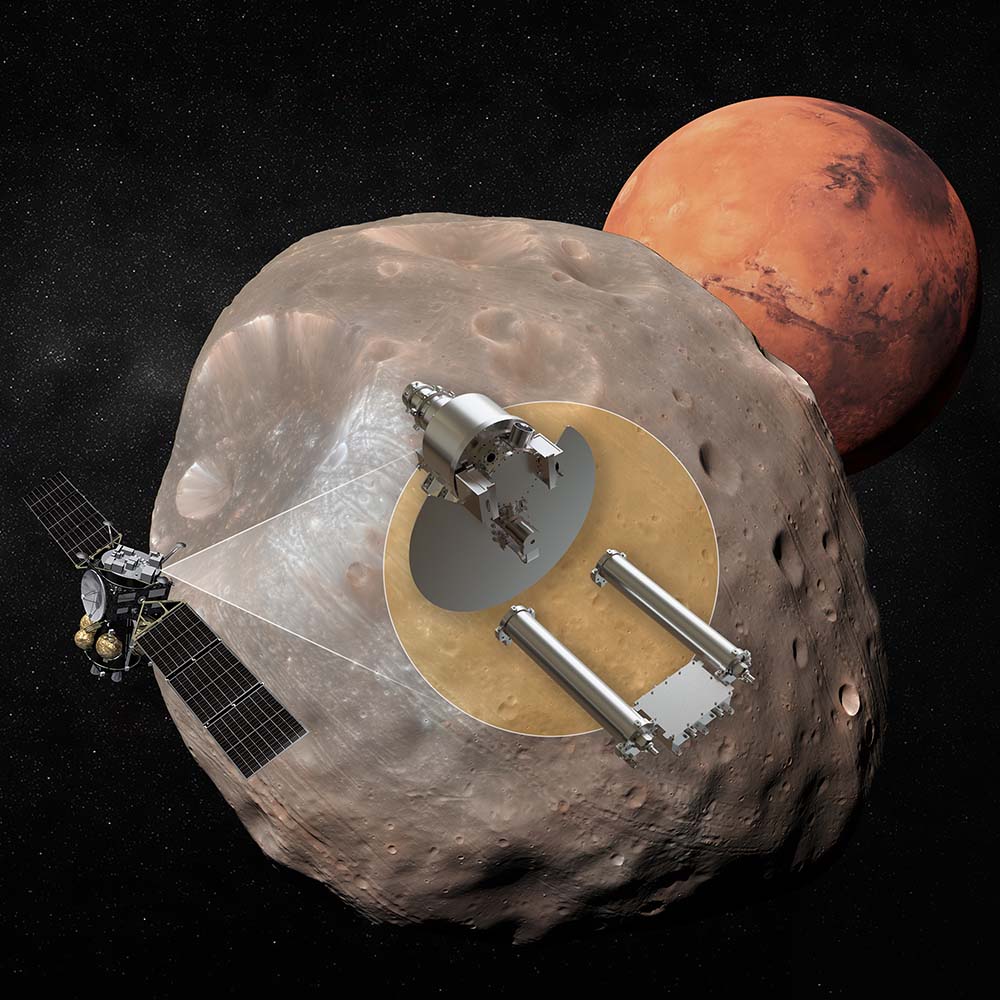Press Release
Mars-Bound Johns Hopkins APL Spectrometer Passes Major Milestone
The team at the Johns Hopkins Applied Physics Laboratory (APL) designing the gamma-ray and neutron spectrometer instrument for the Japan-led Martian Moons eXploration (MMX) mission to Mars’ moons Phobos and Deimos passed its mission confirmation review on May 26, completing a critical milestone that now moves the instrument into its final design phase.
“Passing a confirmation review is a major step toward getting an instrument into space,” said David Lawrence, a planetary scientist in APL’s Space Exploration Sector and the principal investigator on the instrument team. “I am very gratified and thankful for our dedicated and talented team.”
The Mars-moon Exploration with GAmma Ray and NEutrons instrument, or MEGANE (pronounced meh-gah-nay, the Japanese word for “eyeglasses”), is one of multiple instruments that will ride aboard MMX and is one of NASA’s contributions to the mission, which is led by the Japan Aerospace Exploration Agency (JAXA).
The MMX mission, scheduled to launch in 2024, aims to solve the outstanding mystery of where Mars’ moons originated. MEGANE will be vital to answering this question, specifically for Phobos.
Researchers surmise the Martian moons most likely are remnants of a collision between Mars and a space rock the size of the largest asteroids or are small asteroids captured by Mars. The key to determining the correct origin comes down to the chemical elements that make up the moons.
“Our lack of knowledge about Phobos’ composition is one of the primary missing pieces to understand how Phobos formed,” Lawrence said.
Using two helium-3 gas sensors and a cryogenically cooled sensor, MEGANE will be able to “see” neutrons and gamma rays emitted by the elements on Phobos. These gamma rays and neutrons result from cosmic rays continually colliding with atoms on and beneath the moon’s surface. By measuring these emissions, MEGANE can determine Phobos’ elemental composition for the first time, as well as help characterize processes that modify its surface.
With the instrument’s confirmation now passed, the team is one step closer to making those deciding measurements.
“The team is really excited to move forward into the next phase, despite all the challenges that COVID-19 has brought upon us,” said Michael Cully, an engineer at APL and the MEGANE team’s project manager.
Since mid-March, as the state of Maryland and the country grappled with the COVID-19 pandemic, the Lab directed APL staff to work remotely to the maximum extent possible. The team was already highly integrated before the pandemic, allowing team members to work remotely and still get the job done.
“We’ve developed a great relationship with the MMX project team in Japan over the past two years, despite some of the logistical challenges with language, remote meetings and, of course, COVID-19,” said MEGANE Instrument System Engineer Brian Schratz, from APL. “The exchange of cultures and methods is a rich, new learning experience, and I’m looking forward to our continued collaboration.”
In the coming months, the team will build and test prototype hardware at APL to show that MEGANE will be able to withstand the thermal and mechanical environments expected during launch, cruise and orbit around Phobos. The team will later deliver the test hardware to Japan to demonstrate how the sensor electronics will interface with the MMX spacecraft. The instrument will go through a critical design review with NASA in February 2021.
MEGANE is being developed under NASA’s Discovery Program, which provides low-cost access to space using principal investigator-led space science investigations. The MEGANE science team includes investigators from APL, Lawrence Livermore National Laboratory, NASA Ames Research Center and JAXA. To learn more about MEGANE and the MMX mission, please visit http://megane.jhuapl.edu.
